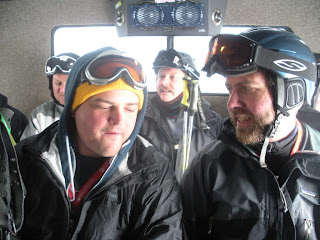By Susan Schroer
Rafting is at the top of my “Favorite Things to do in Utah” list. Whether it’s a thrilling ride on class IV rapids, or a leisurely float through amazing scenery, rafting is a must-do on one’s bucket list. Cataract Canyon is known for breath-taking scenery, big waves and miles of solitude. When I first heard of an opportunity to take a late-season trip through “Cat” I thought, ‘Yes! How, when and where do I sign-up?’ Cat would be a new rafting challenge for me, since it’s much more desolate with more technical rapids than what I had previously been through. There would be new surprises and I couldn’t wait to find out what they would be.
 |
| Swimming flat waters of "Cat" |
The closer we got to Potash, I started to notice a change in the air – the stars appeared to be more abundant, the sounds of other cars seemed to cease to exist and there was a fragrance in the air from the smell of sage brush coming to life after a recent desert rain. It was past midnight by the time we arrived but no one was tired because we were all too excited about what the next four days had in store for us. My eagerness for morning to come, much like a kid on Christmas Eve, kept me staring up at the sky. With everything else around me giving into the night, I finally start to settle down but not before watching a brilliant shooting star blaze across the Milky Way.
 | ||
| View from Dead Horse Point |
After 28 miles on the river we come to the first campsite. Dinner is made and we all set-up our camp chairs to face the river. Great blue herons fly just above the surface of the water as the setting sun casts the sandstone walls from orange to pink to red and finally to purple. That night it was much easier to fall asleep, once again staring at shooting stars and listening to the Colorado lull me to bed.
 |
| Proposal Cake |
Day three was an exciting day; it’s the day of all the big rapids. Not long after leaving camp, we see a sign that reads “Danger.” The rapids are close. We all pull-off onto the shore one last time to have a pep and safety talk, re-check all the boats and fasten our personal flotation devices. There are so many rapids in this section of the river that they are simply numbered rather than named, with the exceptions of Big Drops 1, 2, & 3. Looking at the river map, there’s an area nick-named mile-long rapid, an area that has a series of rapids and wave trains that feel like they extend for a mile.
 | |
| Paddle raft preparing for first small rapids |
Next we steer into rapid 15 and the area known as mile-long rapid. To navigate through this one we need to paddle around a huge boulder and then run into the next hole backwards. We clear the rock but we’re unable to correct the direction of the raft against the strong current and we hit the next rapid a little side-ways. There’s a jolt when we crash into the rapid and I somersault off the side of the boat. Down I go into the water but my PFD bobs me back up and my head hits the bottom of the raft, one of my greatest fears come true of being stuck under the boat. I scramble against the boat and let the current carry me back to the surface. I gasp for air and the rest of the paddle crew is right beside me to pull me and another boater back into the raft. It probably all happened in a matter of split-seconds, but when you’re under a boat and in the rapids, it seems much longer.
We hit two more rapids before we can take a break and all I can do is hold on since I lost my paddle in the spill. Half-way through the section of rapids, others want to take a try at being on a paddle-raft; drenched and exhausted, I gladly switch spots with someone on an oar-rigged raft. It’s a good choice as the next rapids we go through are the notorious Big Drops 1, 2, & 3. Everything I’ve heard about these rapids lived up to the hype of being fast, big, a little scary, very thrilling and each one gets bigger than the last. Before hitting Big Drop 3, we stop and scout the situation (Legend has it that Major John Wesley Powell ordered his crew to portage around it when they were the first to navigate this canyon).
 |
| Looking back on Big Drop 3 |
That night we camp close to the cliffs. There’s almost a full-moon and as it rises, it casts eerie shadows that are constantly changing along the canyon walls. Exhausted from the day’s adventures, my sleeping-bag becomes my new best friend.
 |
| Hitting a wave in "Corkscrew" rapid |
As we load-up and leave, we’re all tired, sun-burnt, a little stinky and bruised but we all silently look back at the river and lake behind us and know that we’d all jump back onto a raft tomorrow if the opportunity arises.
Right now, as I sit at my desk and think back on this trip, I gaze up to the mountains. The rafting season is over, but a new cycle has just begun - snow has started to fall and I pray for a big snow pack this year in hopes of a lot of run-off and day-dream of bigger rapids to come next season.
























